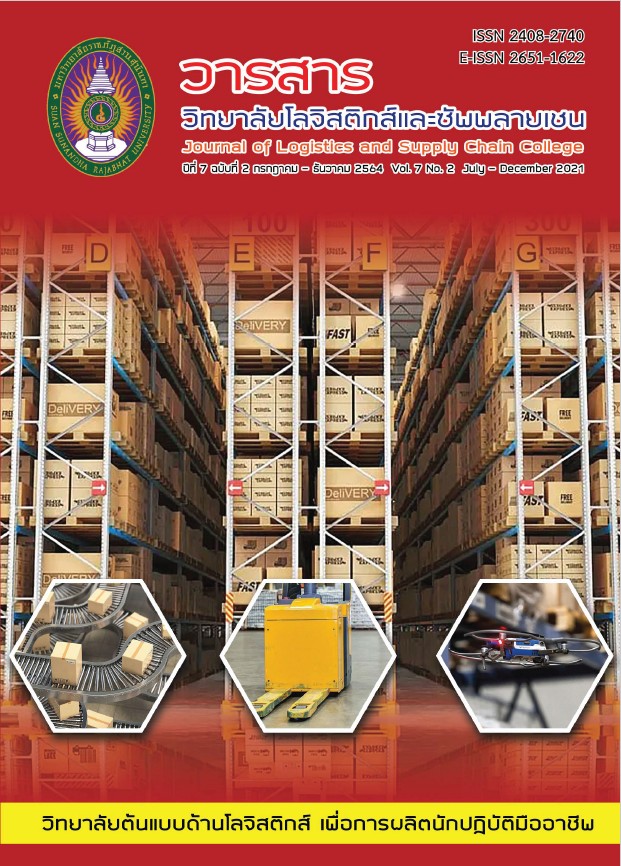Reducing the Inventory Cost of Electronics Manufacturing Companies to Improve Inventory Management Policy
Keywords:
Cost reduction, Inventory management, Epoxy moldAbstract
The objective of this research is twofold, (1) to study the inventory costs reduction of major raw material used in manufacturing electronic equipment for the case study company, (2) to present the means to improve inventory policy and management, for tackling high inventory costs and raw materials’ shortage. This research implemented problems analytic research methodology to find the causes of un-matching between raw materials inventory with their demand. As urgently requested by management, we select the Epoxy mold as the first priority to be studied due to several reasons: (1) it has the most frequent problems occurrence; (2) it has to be imported, therefore its’ lead time is longer and more deviated than others. The Epoxy mold has 35 sub-items where we include their relevant data to analysis using the ABC classification system. Then, we implement Minitab and MS Excel to forecast and analyze Epoxy mold consumption respectively, where we collected Epoxy mold consumption data from Jan 2017 to Dec 2020. Lastly, we calculate the reorder point. The findings found that, by applying the new inventory policy incorporated with up to level order point system (Min-Max), we can save all Epoxy mold (A group items) inventory costs by 5,191,643 Baht/year when comparing with the business as usual inventory policy. The case studied company can further implement the reorder point and appropriate order quantities for other items. Also the obtained result can be used as initiative for transfer the inventory policy for A class raw materials to implement vendor inventory management as planned in the near future.
References
กึกก้อง กล่อมวิสุทธิ์ และณัฐพัชร์ อารีรัชกุลกานต์. (2555). การประยุกต์ใช้ระบบบริหารวัสดุคงคลังโดยผู้ส่งมอบสำหรับโรงงานผู้ผลิตเซมิคอนดักเตอร์ในจังหวัดพระนครศรีอยุธยา. มหาวิทยาลัยธุรกิจบัณฑิตย์.
กิ่งกาญจน์ ผลิกะ และนพปฎล สุวรรณทรัพย์. (2559). การบริหารสินค้าคงคลังโดยการประยุกต์ใช้ทฤษฎี ABC Classification Analysis เทคนิค EOQ Model และวิธี Silver-Meal: กรณีศึกษา บริษัท XYZ. วารสารวิจัยราชภัฏพระนคร สาขามนุษยศาสตร์และสังคมศาสตร์, 11(1), 102-114
คำนาย อภิปรัชญาสกุล. (2560). การจัดการต้นทุนคลังสินค้า. พิมพ์ครั้งที่ 1. กรุงเทพมหานคร: โฟกัสมีเดีย แอนด์พับลิชชิ่ง.
คำนาย อภิปรัชญาสกุล. (2560). การจัดการสินค้าคงคลัง. พิมพ์ครั้งที่ 4. กรุงเทพมหานคร: โฟกัสมีเดีย แอนด์พับลิชชิ่ง.
ณัฏภัทรศญา เศรษฐโชติสมบัติ. (2560). การใช้เทคโนโลยีสารสนเทศและนวัตกรรมในโลจิสติกส์ โซ่อุปทานและโซ่คุณค่า. วารสารวิทยาลัยโลจิสติกส์และซัพพลายเชน, 3(1), 4-15.
ณัฎภัทรศญา เศรษฐโชติสมบัติ และประสิทธิ์ การนอก. (2563). การเพิ่มประสิทธิภาพการบริหารพื้นที่คลังสินค้าอุตสาหกรรมชิ้นส่วนยานยนต์ด้วยแนวคิดเชิงบูรณาการ: กรณีศึกษาบริษัท โตไคริคะ (ไทยแลนด์) จํากัด. วารสารวิชาการวิศวกรรมศาสตร์ ม.อบ., 13(1), 127-140.
นงลักษณ์ วิรัชชัย. (2553). สถิติบรรยายและสถิติพาราเมตริก มหาวิทยาลัยสุโขทัยธรรมาธิราช. กรุงเทพมหานคร:โรงพิมพ์มหาวิทยาลัยสุโขทัยธรรมาธิราช.
ธิดา ฉานแสงทอง และสมพงษ์ ศิริโสภณศิลป์. (2560). ปริมาณการสั่งซื้อที่เหมาะสมของสินค้าที่ทดแทนกันได้. จุฬาลงกรณ์ธุรกิจปริทัศน์, 39(4), 105-126.
บุญเลิศ วงศ์เจริญแสงสิริ. (2562). การลดต้นทุนและรักษาระดับการให้บริการในการจัดการสินค้าคงคลังด้วยระบบการตรวจสอบตามรอบ กรณีศึกษา บริษัทธุรกิจค้าปลีก. วิศวกรรมสารเกษมบัณฑิต, 8(3), 51-71.
พีระพรรณ ภูมิดี, ฉัตรรัตน์ โหตระไวศยะ และ ชณิชา หมอยาดี. (2563). การปรับปรุงการจัดเก็บและควบคุมสต็อกสินค้าแผนกฟู้ดของบริษัทท็อปส์มาร์เก็ต ด้วยแนวคิดลีนเพื่อลดการสูญเสีย. วารสารวิทยาลัยโลจิสติกส์และซัพพลายเชน, 6(2),75-88.
เพ็ญภัทร์ อารี และนระเกณฑ์ พุ่มชูศรี. (2558). การวางแผนการผลิตสำหรับชิ้นส่วนยานยนต์ที่มีความต้องการสินค้าไม่แน่นอน. วิศวกรรมสารฉบับวิจัยและพัฒนา, 26(3), 71-79.
วุฒิชัย วงษ์ทัศนีย์กร และชยกฤต เจริญศิริวัฒน์. (2560 ). การประยุกต์ใช้ระบบบริหารสินค้าคงคลังสำหรับวัตถุดิบที่เน่าเสียได้ : กรณีศึกษาโรงงานผลิตปลากระป๋อง. วารสารวิทยาศาสตร์และเทคโนโลยี, 19(4), 15-29.
วัลลภ ภูผา. (2557). การประยุกต์ใช้เทคนิคการจำลองสถานการณ์แบบมอนติคาร์โล เพื่อหาปริมาณการสั่งซื้อที่เหมาะสม กรณีศึกษาการจัดซื้อวัตถุดิบในโรงงานผลิตอาหารแปรรูป. วิศวกรรมสาร มก, 88(27), 41-56.
แสงระวี รุ่งวิถี และปณัทพร เรืองเชิงชุม. (2560). แนวทางการจัดการความเสี่ยงที่ส่งผลต่อต้นทุนการจัดการสินค้าคงคลังของร้านขายยา CDE ในจังหวัดขอนแก่น. วารสารเกษตรศาสตร์ธุรกิจประยุกต์. 11(5), 46-62.
สายน้ำ ฤทธิ์อิ่ม และอรอุไร แสงสว่าง. (2556 ). นโยบายการควบคุมสินค้าคงคลังโดยการใช้คำสั่งซื้อแบบถาวร : กรณีศึกษา. วารสารวิชาการเทคโนโลยีอุตสาหกรรม, 9(3), 105-117.
อร่าม พิมพ์ผกา, ศักดิ์ชาย รักการ, ปพน สีหอมชัย และอนัญญา จินดาวัฒนะ. (2557). การลดต้นทุนสินค้าคงคลัง:กรณีศึกษา บริษัทติดตั้งและจำหน่ายระบบดับเพลิง. วารสารวิศวกรรมสารเกษมบัณฑิต, 4(2), 1-11.
Bain & Company. (2011). Inventory management: 10 questions to diagnose your inventory Health, Retrieved 15 March 2019, from: www.bain.com/publications/articles/
inventory-management-10-questions-inventory-health.aspx.
Bensoussan, A., Çakanyildirim, M., Li, M., & Sethi, S.P. (2016). Managing inventory with cash register information: Sales recorded but not demands. Production and Operations Management, 25(1), 9–21.
Calli, M.K., & Weverbergh, M. (2009). Forecasting newspaper demand with censored regression. Journal of the Operational Research Society, 60(7), 944–951.
Chen, L. (2010). Bounds and heuristics for optimal Bayesian inventory control with unobserved lost sales. Operations Research, 58(2), 396–413.
Investopedia. (2021). Economic Order Quantity (EOQ). Retrieved 22 April 2021,From:https://www.investopedia.com/terms/e/economicorderquantity.asp
#:~:text=Economic%20order%20quantity%20(EOQ)%20is,in%201913%20by%20Ford%20W.
Ramanathan, U., & Muyldermans, L. (2010). Identifying demand factors for promotional planning and forecasting: A case of a soft drink company in the UK. International Journal of Production Economics, 128(2), 538–545.
Sachs, A.-L., & Minner, S. (2014). The data-driven newsvendor with censored de- mand observations. International Journal of Production Economics, 149, 28–36 .


